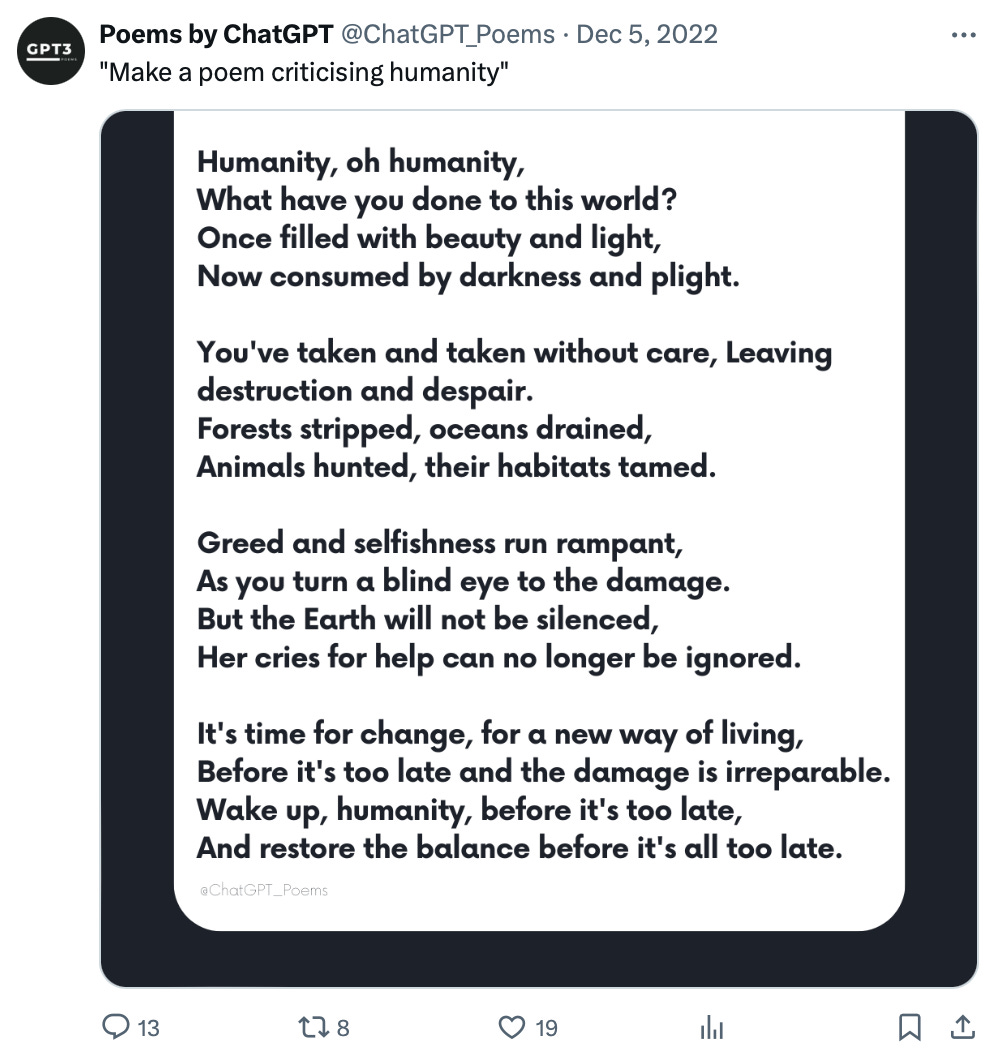Verses Amidst Chaos
When ChatGPT was launched, the first striking examples of its power were poems. Yes, poems.
This is both unsettling and fascinating. Why? Because poetry demands a subtle mastery of language, emotional sensitivity, and the ability to weave metaphors and symbols. Poems are not just arrangements of words; they are bridges between our conscious and subconscious, fragments of our collective soul.
"Poetry is the prettiest nickname we give to life," said Jacques Prévert. If an AI can write poems that resonate, it questions the very essence of our humanity.
Of course, poetry is timeless, enduring, and cyclical. It resurfaces with force during times of crisis. In turbulent moments, people seek expressions that capture the depth of their emotions. With its conciseness and intensity, poetry offers a precious outlet. It encourages reflection, questioning, and action by commenting on social and political events. Historically, this trend is evident: the war poems of Wilfred Owen, the works of Maya Angelou during the civil rights movement, and the resurgence of poetry with poets like Amanda Gorman during the pandemic and Kathy Jetnil-Kijiner addressing the climate crisis, or even Rupi Kaur, with her 5 million followers on Instagram, capturing the nuances of contemporary emotional struggles. As Baudelaire so aptly said, "Poetry is what is most real, what is completely true only in another world.”

Code and Verses
Keen observers will have noted a unique contemporary infiltration of technology into poetry. One fascinating example is the collection ./code –– poetry, where programmer Daniel Holden and poet Chris Kerr merge their skills to create works that read like poems and execute like code.

In by_conspiracy_or_design.js, the duo uses JavaScript to create a golden spiral in ASCII art. This poem critiques the notion of elegance in programming, using complex code rather than simplicity to draw this spiral, challenging traditional ideals of clarity and simplicity in computing. The resulting animation is both a visual work and a commentary on aesthetics in programming.
This intersection demonstrates that poetry and technology are not opposed but complementary, inviting a reconsideration of the separation between science and arts. The book Poetic Species explores this relationship, where E.O. Wilson and Robert Hass discuss the convergence between science and poetry. Wilson observes that "formal imagination in art... is always working on that problem", emphasizing that artistic creativity and scientific rigor are two aspects of the same quest for understanding.
Poetic Experiments
The fusion of technology and poetry takes various forms. For instance, the Kickstarter project, The Poetry Clock, brought together 844 contributors and raised £95,326 to create an alarm clock that recites poems, thus transforming a daily ritual into a moment of inspiration.

The Poetry Camera, an open-source device, goes further by capturing images and generating verses using AI. The poems, printed on paper rather than saved digitally, create a transient artistic experience. Kelin Carolyn Zhang, one of the creators, explains: "It’s about making something entirely new with its new technology and bringing out that inner child again. For this project, it’s not about making money — it’s about making that childish wonder possible again."

When we reflect on it, a deeper dimension emerges. In the age of social media, we no longer fully experience the present moment, as we are consumed by capturing each instant. This leads to nowstalgia – the nostalgia for the present moment not fully lived. Adding poems to these moments can enrich the experience, unveiling unsuspected nuances through poetic metaphors.
After nowstalgia, poeminance? It invites us to reconsider the present moment, revealing layers of meaning over time. Now but forever.
Even in real life, poetry is infused. The RATP (the public transport operator for the city of Paris and its suburbs) organizes contests, offering winners the opportunity to see their poems displayed in subway cars. Similarly, the cosmetics brand Lush has recently integrated poetry into its products through a collaboration with The Poetry Pharmacy, specialized in "prescription poetry".
This initiative has brought forth bath bombs like "Slow Down" and "Wild Remedy," which contain hidden poems inside, transforming the bath experience into a moment of reflection and serenity.
The shared thread among all these examples? A candid snapshot, a rushed awakening, a shopping spree, a subway journey...
Poetry: An Invitation to Slow Down
In a world dominated by speed and superficiality, poetry acts as a gentle yet transformative force of friction. It encourages us to decelerate, to contemplate, offering a welcome pause. The succinctness of poetry, its ability to convey deep meanings in few words, makes it particularly suited to this era.
Poetry also engineers serendipity, unveiling layers of meaning over time. Through its language, metaphors, and symbols, it leads to unexpected moments of insight. Much like data compression, poems condense complex meaning, revealing depths upon engagement. This reflective approach encourages readers to ponder every word, fostering serendipitous discoveries less common in narrative art forms like novels or films.
Some may argue that poetry is not accessible to everyone and that it is too complex. However, this view often misses the true essence of poetry. As Saint-John Perse so aptly expressed: "The darkness for which it is criticized is not due to its inherent nature, which is to illuminate, but to the very night it explores (...)." Whether generated by AI or written by humans, poetry reminds us that even in the midst of progress, the essence of humanity lies in contemplation.
MD






